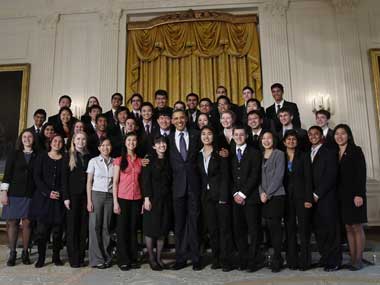Chinese-American and Indian-American students are at the head of their class, according to a new report issued by the National Foundation for American Policy. Research by Stuart Anderson, the executive director of the non-profit public policy research organisation, found that 70% of the finalists in the 2011 Intel Science Talent Search competition—previously known as the “Junior Nobel Prize”—were the children of immigrants who primarily hailed from China and India. (The 2011 winner, Evan O’Dorney, is not, however, of Chinese or Indian descent.) [caption id=“attachment_15056” align=“alignleft” width=“380” caption=“Finalists of the Intel Science Talent Search with US President Barack Obama. Nearly 70% of the finalists this year were children of immigrants, predominantly Chinese-American or Indian-American. Jim Young/Reuters”]  [/caption] But 16 of the 40 finalists this year had parents originally from China, and 10 had parents born in India. And these students appeared predisposed to math and science excellence, with 60% of the competition finalists born to parents who immigrated to the US on H-1B visas. Anderson also noted that the immigrant parents in his study placed a heavy emphasis on education. The study also has potential policy ramifications. As Anderson wrote in his research findings, “preventing the entry of H-1B visa holders, skilled immigrants, and family-sponsored immigrants would shut off the flow of a key segment of America’s next generation of scientists and engineers – the children of immigrants – because we would not have allowed in their parents.” Anderson’s new report dovetails with his 2004 research based on data from the a previous Talent Search and the U.S. Math Olympiad, which found that 60% of the top science students and 65% of the top math students in the US were the children of immigrants. Young geniuses The Talent Search asks high school students to develop a project that displays evidence of “research ability, scientific originality, and creative thinking.” It has been referred to as the “Junior Nobel Prize,” and it’s a solid harbinger of future academic and scientific success. For instance, 70% of Talent Search winners end up earning Ph.D.s or MDs, and seven have even gone on to win a Nobel Prize. The 2011 Indian-American finalists include: • Shubhro Saha, who used a supercomputer to identify a “possible mechanism for the interaction of the catalyst in hydrogen production,” so it will be easier to use hydrogen as an alternative energy source. Saha, who has presented his research at General Electric, lives in Avon, Connecticut. • Prithwis Kumar Mukhopadhyay, who investigated whether a food additive called carrageenan could be linked to cancer. He was born in India. • Rohan Mahajan, who researched ways to improve photoelectrochemical cell efficiency; his findings could apply to solar cells. Mahajan lives in Silicon Valley (his father works at Cisco), and he said his bicultural background inspired his research. “I got interested in energy production because whenever we went to India, the power always went out,” he told researchers.
In the search for science talent in the US, children of immigrants ruled the field.
Advertisement
End of Article


)

)
)
)
)
)
)
)
)



